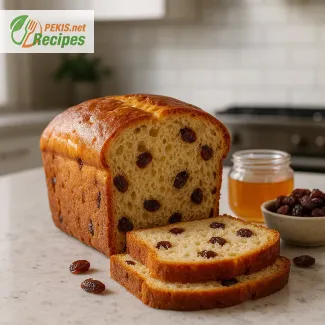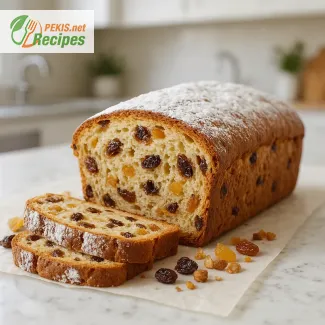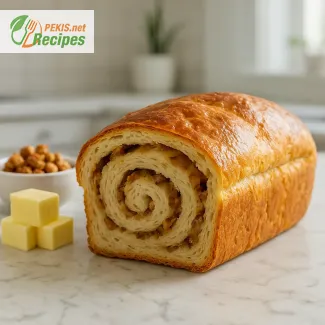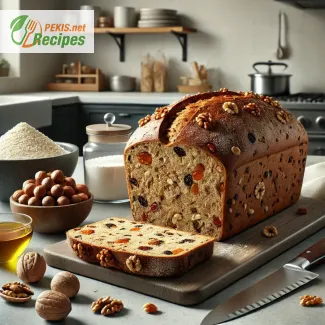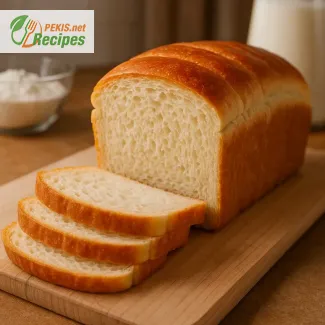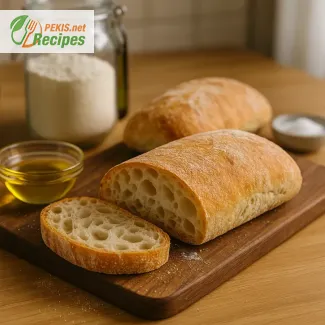
Perfecting Italian Artisan Bread for Warm Weather Enjoyment
A professional introduction to long-fermented ciabatta with olive oil
When the summer heat rises, the craving for light, artisan bread with a crisp crust and airy interior becomes irresistible. Among all Mediterranean-style breads, few evoke the same sensory satisfaction as a perfectly baked homemade ciabatta. Characterized by its open crumb, chewy texture, and delicate golden crust, ciabatta is the quintessential companion for summer meals—ideal for bruschetta, antipasti platters, grilled vegetables, or simply dipped in extra virgin olive oil.
What makes this ciabatta bread recipe exceptional is not just its Italian heritage, but the method behind its success: a long, cool fermentation period that allows the dough to develop deep flavor, remarkable elasticity, and that unmistakable artisanal aroma. This slow proofing process—combined with high hydration and quality olive oil—transforms simple ingredients into a rustic masterpiece worthy of any summer table.
The heritage of ciabatta: from Veneto to your kitchen
Originally created in the 1980s in the Veneto region of Italy, ciabatta (meaning "slipper" in Italian, due to its flat shape) quickly became a staple of Italian bakeries and has since spread across global tables. Unlike denser breads, ciabatta was developed to be lighter, airier, and more suited to modern palates seeking contrast in texture—soft interior with a crackly crust.
While commercial versions can often be dry or bland, authentic ciabatta bread requires patience, proper dough handling, and attention to fermentation. Using cold-proofing techniques and avoiding shortcuts is key to achieving that characteristic open crumb and mild sour flavor. The addition of extra virgin olive oil adds richness, elasticity, and subtly enhances the aroma, particularly during summer when bread is often served as a standalone delicacy.
Why long fermentation makes all the difference
Long fermentation is more than a trend; it’s a return to time-honored tradition. Allowing the dough to ferment slowly (12 to 24 hours in the refrigerator) gives natural enzymes time to break down starches, improve texture, and create complexity of flavor that can’t be mimicked by fast-rise methods.
For ciabatta, this technique is especially crucial. The high-hydration dough (typically 75–80%) benefits from an extended rest, which encourages gluten development without overworking the dough. This results in the large air pockets that ciabatta is known for and a tender, chewy bite that complements summer produce and grilled dishes. With every bite, you'll experience layers of flavor formed naturally over time.
The role of olive oil in Mediterranean baking
Olive oil plays a dual role in this ciabatta: functional and flavorful. It softens the dough, contributes to the thin, crispy crust, and adds an earthy undertone that pairs beautifully with sun-ripened vegetables, soft cheeses, and cured meats. When used in the dough—not just as a finishing oil—olive oil enhances extensibility, allowing the wet dough to stretch and form bubbles more easily during the final proofing.
Choosing a high-quality extra virgin olive oil is essential, particularly for a summer bread recipe like this. Its fragrance and slight peppery bite elevate the entire loaf, making it ideal for toasting, sandwich building, or simply breaking apart with fingers at an outdoor table.
Ideal occasions and pairings for summer ciabatta
Few breads feel more at home on a warm evening table than ciabatta. Its versatile nature means it complements everything from marinated grilled zucchini and eggplant to lemony chicken skewers, caprese salads, or chilled seafood. Toast slices lightly and rub with fresh garlic, top with chopped tomatoes and basil for a classic bruschetta, or serve with a drizzle of olive oil and balsamic reduction as a minimalist starter.
Because of its light crumb structure and ability to absorb sauces and oils, ciabatta is also excellent for picnic sandwiches, panini, and even breakfast toasts. It carries ingredients without overwhelming them and maintains its structure, even when loaded with juicy fillings.
Techniques and tools for artisan-level results
To replicate an authentic Italian ciabatta bread at home, a few tools and methods make all the difference. A stand mixer with a dough hook helps handle the wet dough with minimal mess. A dough scraper and floured bench are essential for shaping the sticky mass without deflating it.
Using a baking stone or steel and introducing steam into the oven creates the optimal baking environment—ensuring oven spring, a blistered crust, and that artisan-style finish. For those new to high-hydration baking, patience is crucial; the dough will feel more like a batter than a traditional loaf, but with practice, you’ll master the folding, resting, and shaping that make true ciabatta possible.
Why this recipe stands out
This homemade summer ciabatta recipe prioritizes authenticity and results over speed. With its long fermentation, minimal yeast, and generous olive oil content, it delivers the kind of bread you’d find at a countryside bakery in southern Italy. The technique may seem unconventional at first—but once you experience the complex flavor, crackly crust, and open crumb, you’ll never return to fast-rise breads again.
Perfect for warm weather entertaining or everyday summer meals, this ciabatta brings artisanal flavor to your kitchen with just a handful of ingredients, time, and a bit of technique. Whether you enjoy it as a sandwich base, grilled with toppings, or served beside chilled wine and olives, it will quickly become a seasonal favorite.
1. Prepare the ciabatta dough:
In a large mixing bowl, combine 500 g wheat flour, 3 g dry yeast, and 10 g salt. Stir dry ingredients together. Add 400 ml lukewarm water and mix until a wet, sticky dough forms. Add 30 ml olive oil and continue mixing until fully incorporated. The dough will be very soft and sticky – this is normal.
2. First rest and stretch & folds:
Cover the bowl with plastic wrap and let it rest for 30 minutes at room temperature. After resting, perform a set of stretch and folds: pull one side of the dough and fold it over itself; repeat on all four sides. Repeat this process every 30 minutes for 2 hours (4 sets total), keeping the dough covered between sets.
3. Cold fermentation:
After the final stretch and fold, cover the bowl tightly and refrigerate for 12 to 16 hours. This long fermentation gives the ciabatta its deep flavor and signature texture.
4. Shaping:
Lightly flour your work surface with semolina or wheat flour. Turn the dough out gently, trying not to deflate it. Dust the top with flour and divide it into 2 equal rectangular loaves. Do not knead or shape further—just separate and stretch lightly if needed. Place on a floured cloth or parchment paper, cover loosely, and let rise for 1 hour at room temperature.
5. Preheat the oven:
Preheat your oven to 240°C (464°F) with a baking stone or steel inside. Place a metal tray at the bottom of the oven to create steam.
6. Baking:
Carefully slide the dough onto the preheated stone. Pour a cup of hot water into the lower tray to create steam and quickly close the oven. Bake for 20–25 minutes, or until the crust is golden and crisp. Let cool completely on a wire rack before slicing.
Elevating Classic Ciabatta: Modern Techniques and Ingredient Innovations
Expert advice to enhance flavor, texture, and nutritional value
While the traditional homemade ciabatta bread recipe relies on minimal ingredients and long fermentation, there’s room for innovation and refinement without losing its authentic charm. Enhancing the original formula can result in a more complex flavor, improved texture, and even better nutritional balance—all while maintaining the rustic simplicity that defines this beloved Italian loaf.
Adding sourdough starter for depth and digestibility
One of the most effective ways to improve ciabatta is to incorporate a sourdough starter into the dough. Replacing part of the dry yeast with a mature sourdough culture adds mild tanginess, deeper aroma, and better keeping qualities. The natural acids produced by fermentation also help break down gluten, making the bread easier to digest for some individuals. This tweak doesn’t drastically alter the process but does extend the bulk fermentation phase slightly, usually by 1–2 hours.
Sourdough-enhanced ciabatta tends to have a more caramelized crust and complex crumb structure. It’s also more resistant to staling, which is particularly useful in warm weather when bread tends to dry out faster.
Using specialty flours for a richer profile
Substituting a portion of the wheat flour with other types can enhance the nutritional value and flavor. A popular addition is spelt flour, which contributes nuttiness and a slightly sweet finish. Replacing up to 20% of the total flour with whole wheat flour increases fiber and minerals while giving the crumb a darker tone and denser bite. However, going beyond this ratio can reduce the loaf's signature open structure.
Another exciting option is incorporating semolina flour—not just for dusting but as part of the dough itself. Semolina gives a beautiful golden hue and a slightly crispier crust, perfect for summer sandwiches and grilled accompaniments.
Infusing herbs and roasted ingredients
Ciabatta’s subtle flavor makes it an excellent canvas for infusions. Adding fresh herbs like rosemary, thyme, or basil into the dough can create a garden-fresh taste. Finely chopped roasted garlic, sun-dried tomatoes, or black olives introduce savory bursts of flavor and pair exceptionally well with olive oil.
For best results, add these ingredients during the second fold of the bulk fermentation to prevent tearing the dough structure. Keep portions modest—about 10–15% of the total dough weight—to avoid overwhelming the gluten network or creating excess moisture.
Hydration tweaks and handling techniques
Ciabatta’s identity is rooted in its high hydration, which creates the iconic open crumb and chewy texture. While 80% hydration is standard, increasing it slightly to 82–85% can yield an even airier result—provided the baker is comfortable handling extremely sticky dough. To manage higher hydration:
- Use wet hands and tools when folding or shaping.
- Rely on stretch and folds instead of kneading.
- Allow extra resting time between folds to relax gluten.
This adjustment enhances oven spring and produces dramatic internal holes—perfect for soaking up oils and dressings.
Healthier ingredient substitutions
For a more health-conscious version, consider a few strategic swaps:
- Replace some white flour with stone-ground whole grain flour for increased fiber and micronutrients.
- Substitute table salt with unrefined sea salt, which retains trace minerals.
- Use cold-pressed organic olive oil, which provides higher polyphenol content.
To lower the glycemic index, include chia seeds or flax meal (about 5–10 g) in the dough. These additions increase omega-3 fats and add a light nutty flavor.
Avoiding common mistakes in homemade ciabatta
Even seasoned bakers can run into issues when working with high-hydration dough. Here are key pitfalls and how to prevent them:
- Overmixing or over-kneading: This breaks down the gluten structure and leads to a dense, sticky loaf. Use gentle folds instead.
- Insufficient fermentation: Rushing the process results in bland, underdeveloped flavor. Let the dough rest for at least 12 hours in the fridge.
- Too much flour during shaping: This creates a tough crust and blocks oven spring. Use just enough to prevent sticking.
- Improper oven setup: Without steam, the crust hardens too quickly and prevents expansion. Always add a water tray or spray mist at baking start.
Why homemade ciabatta beats store-bought
While supermarket loaves often sacrifice quality for shelf life, homemade ciabatta prioritizes freshness, ingredient transparency, and taste. You control every step—from flour selection to fermentation timing—allowing you to tailor the recipe to your preferences and health needs.
Freshly baked ciabatta boasts a delicate aroma, superior crust, and tender interior that commercial versions rarely achieve. It also avoids preservatives, artificial softeners, and excess sodium found in mass-produced breads.
Seasonal inspiration: enhancing with summer flavors
In the spirit of warm-weather cooking, try incorporating seasonal touches:
- Sprinkle the top with coarse sea salt and lemon zest before baking for a refreshing twist.
- Add a hint of chili flakes for subtle heat, especially when pairing with grilled meats.
- Use infused olive oils (e.g., garlic, basil, lemon) in the dough for nuanced aromatics.
These enhancements align beautifully with Mediterranean cuisine and make the bread shine as more than just a side—it becomes a centerpiece of the meal.
Allergens present in the recipe:
- Wheat (gluten)
Suggestions for allergen-free alternatives:
- Replace wheat flour with gluten-free all-purpose flour blend with added xanthan gum (results may vary; structure will be less airy).
- Use certified gluten-free yeast and flours to ensure complete gluten-free preparation.
- No dairy or nuts are present; recipe is naturally dairy-free and nut-free.
Vitamins and minerals per serving (approximate):
- Iron 2.1 mg – Supports oxygen transport and energy levels
- Magnesium 20 mg – Aids muscle and nerve function
- Potassium 90 mg – Regulates fluid balance and heart function
- Vitamin E 1.3 mg – Antioxidant and immune support
- Vitamin B1 (Thiamine) 0.2 mg – Supports energy metabolism
- Vitamin B3 (Niacin) 1.7 mg – Aids in skin health and digestion
Antioxidants per serving (approximate):
- Polyphenols 90 mg – From olive oil, support cardiovascular health and reduce inflammation
- Vitamin E 1.3 mg – Protects cells from oxidative stress
- Flavonoids trace amounts – Present in cold-pressed olive oil, support immune modulation and vascular function
